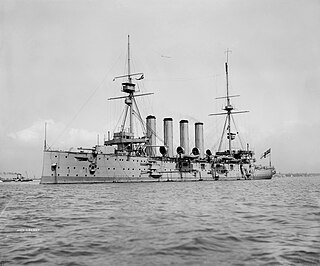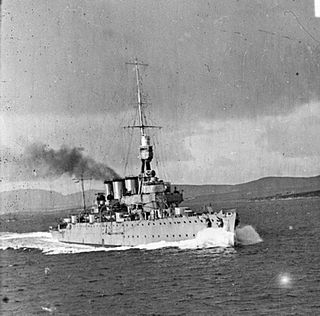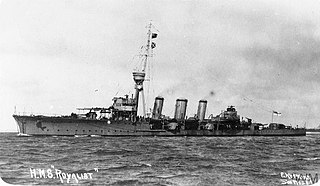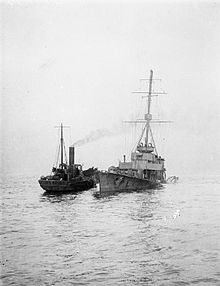Design and description
The Arethusa-class cruisers were intended to lead destroyer flotillas and defend the fleet against attacks by enemy destroyers. The ships were 456 feet 6 inches (139.1 m) long overall, with a beam of 49 feet 10 inches (15.2 m) and a deep draught of 15 feet 3 inches (4.6 m). Displacement was 5,185 long tons (5,268 t ) at normal [1] and 5,795 long tons (5,888 t) at full load. Arethusa was powered by four Brown-Curtis steam turbines, each driving one propeller shaft, which produced a total of 40,000 shaft horsepower (30,000 kW ). The turbines used steam generated by eight Yarrow boilers which gave her a speed of about 28.5 knots (52.8 km/h; 32.8 mph). [2] She carried 840 long tons (853 t) of fuel oil [1] that gave a range of 3,200 nautical miles (5,900 km ; 3,700 mi ) at 16 knots (30 km/h; 18 mph). [3]
The main armament of the Arethusa-class ships consisted of two BL 6-inch (152 mm) Mk XII guns that were mounted on the centreline fore and aft of the superstructure and six QF 4-inch (102 mm) Mk V guns in waist mountings. They were also fitted with a single QF 3-pounder 47 mm (1.9 in) anti-aircraft gun and four 21-inch (533 mm) torpedo tubes in two twin mounts. [2]

HMS Galatea was one of eight Arethusa-class light cruisers built for the Royal Navy in the 1910s. She fought in the First World War, participating in the Battle of Jutland. Following the war, she was scrapped.

The Arethusa-class cruisers were a class of eight oil-fired light cruisers of the Royal Navy all ordered in September 1912, primarily for service in the North Sea. They had three funnels with the middle one somewhat larger in diameter than the others. All served in the First World War. They were found to be very cramped internally.

HMS Southampton was a Town-class light cruiser built for the Royal Navy in the 1910s. She was a member of the Chatham sub-class of the Town class. The ship survived the First World War and was sold for scrap in 1926.

HMS Birmingham was lead ship of the Birmingham group of three ships of the Town-class of light cruisers built by the Royal Navy. Her sister ships were Lowestoft and Nottingham. The three ships were virtually identical to the third group of Town-class ships, but with an additional 6 in (150 mm) gun worked in on the forecastle.

HMS Cressy was a Cressy-class armoured cruiser built for the Royal Navy around 1900. Upon completion she was assigned to the China Station. In 1907 she was transferred to the North America and West Indies Station before being placed in reserve in 1909. Recommissioned at the start of World War I, she played a minor role in the Battle of Heligoland Bight a few weeks after the beginning of the war. Cressy and two of her sister ships were torpedoed and sunk by the German submarine U-9 on 22 September 1914 with the loss of 560 of her crew.

HMS Aurora was an Arethusa-class light cruiser that saw service in World War I with the Royal Navy. During the war, the cruiser participated in the Battle of Dogger Bank and was a member of the Grand Fleet when the main fleet of the Imperial German Navy surrendered to it in 1918. Following the war, Aurora was placed in reserve and in 1920, the cruiser was transferred to the Royal Canadian Navy. Her service with the Royal Canadian Navy was brief, being paid off in 1922. The cruiser was sold for scrap in 1927 and broken up.

HMS Chester was a Town-class light cruiser of the Royal Navy, one of two ships forming the Birkenhead subtype. Along with sister ship, Birkenhead, she was originally ordered for the Greek Navy in 1914 and was to be named Lambros Katsonis. The order was placed with Cammell Laird and production continued for the Greek account after the outbreak of the First World War in August 1914. In 1915 the two cruisers were purchased by the British government. She fought at the Battle of Jutland where casualties included John 'Jack' Cornwell who was awarded the highest honour, aged 16.

HMS Hogue was a Cressy-class armoured cruiser built for the Royal Navy around 1900. Upon completion she was assigned to the Channel Fleet and the China Station. In 1906 she became a training ship for the North America and West Indies Station before being placed in reserve in 1908. Recommissioned at the start of World War I, she played a minor role in the Battle of Heligoland Bight a few weeks after the beginning of the war. Hogue was sunk by the German submarine U-9, together with two of her sister ships, on 22 September 1914.

HMS Nottingham was a Town-class light cruiser built for the Royal Navy just before World War I. She was one of three ships of the Birmingham sub-class and was completed in early 1914. The ship was assigned to the 1st Light Cruiser Squadron (LCS) of the Home and Grand Fleets for her entire career. Nottingham participated in most of the early fleet actions, including the battles of Heligoland Bight, Dogger Bank, and Jutland, helping to sink several German ships during the battles. The ship was sunk by the German submarine U-52 during the Action of 19 August 1916.

HMS Euryalus was a Cressy-class armoured cruiser built for the Royal Navy around 1900. Badly damaged by multiple accidents while fitting out, she was not completed until 1904. She became flagship of the Australia Station that year and was reduced to reserve upon her return in 1905. Recommissioned in 1906, she became a training ship for the North America and West Indies Station before being placed in reserve with the Third Fleet in 1909.

HMS Inconstant was one of eight Arethusa-class light cruisers built for the Royal Navy in the 1910s. She fought in the First World War, participating in the Battle of Jutland. Following the war, she was scrapped.

HMS Phaeton was one of eight Arethusa-class light cruisers built for the Royal Navy in the 1910s. She fought in the First World War, participating in the Battle of Jutland. Following the war, she was scrapped.

HMS Royalist was one of eight Arethusa-class light cruisers built for the Royal Navy in the 1910s. She fought in the First World War, participating in the Battle of Jutland. Following the war, she was scrapped.

HMS Penelope was one of eight Arethusa-class light cruisers built for the Royal Navy in the 1910s. She fought in the First World War, following the war, she was scrapped.

HMS Undaunted was one of eight Arethusa-class light cruisers built for the Royal Navy in the 1910s.

HMS Weymouth was a Town-class light cruiser built for the Royal Navy during the 1910s. She was the name ship of the Weymouth sub-class of the Town class. The ship survived the First World War and was sold for scrap in 1928.

HMS Falmouth was a Town-class light cruiser built for the Royal Navy during the 1910s. She was one of four ships of the Weymouth sub-class. The ship was initially assigned to the Atlantic Fleet upon completion in 1911, but was reduced to reserve in mid-1913. When the First World War began in 1914, Falmouth was transferred to the 1st Light Cruiser Squadron (LCS) of the Grand Fleet and then the 3rd Light Cruiser Squadron at the end of the year. The ship participated in most of the early fleet actions, including the Battles of Heligoland Bight, Dogger Bank, and Jutland, but was only seriously engaged in the latter. She was torpedoed and sunk off Flamborough Head, Yorkshire by German submarines during the action of 19 August 1916.

HMS Lowestoft was a Town-class light cruiser built for the Royal Navy in the 1910s. She was a member of the Birmingham sub-class of the Town class. She survived World War I and was sold for scrap in 1931.

The Active-class cruisers were a trio of scout cruisers built for the Royal Navy shortly before the First World War. They were initially assigned to the First Fleet and became destroyer flotilla leaders in 1914. Amphion and Fearless and their flotillas were assigned to the Harwich Force when the war began in August 1914. They went out on a patrol on the first day of the war and Amphion and her destroyers encountered and sank a German minelayer. On the voyage home, the cruiser struck a mine laid by the German ship and sank. She was the first ship of the Royal Navy to be sunk in the war.

HMS Fearless was one of three Active-class scout cruisers built for the Royal Navy shortly before the First World War. Upon completion in 1913, the ship was assigned to the 1st Light Cruiser Squadron (LCS) of the 1st Fleet. She became flotilla leader of the 1st Destroyer Flotilla (DF) shortly before the start of the war in August 1914 and was transferred to the Harwich Force shortly after it began. Fearless participated in the Battle of Heligoland Bight and the Cuxhaven Raid later that year. The ship was transferred to the Grand Fleet in early 1915 and played a minor role in the Battle of Jutland the following year.



















